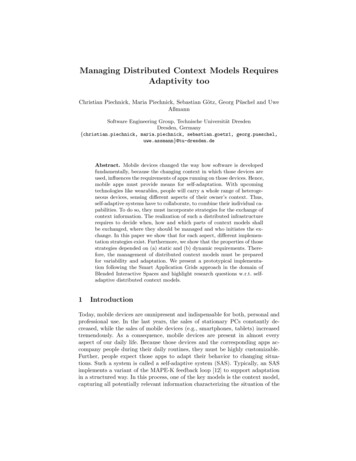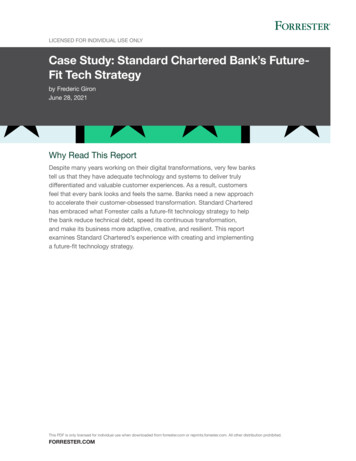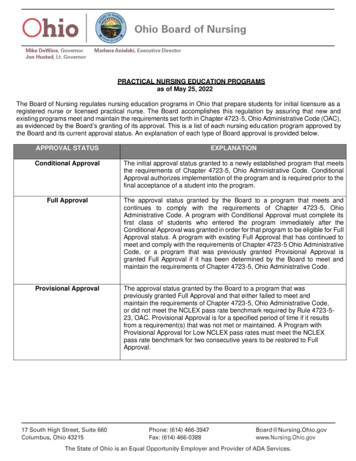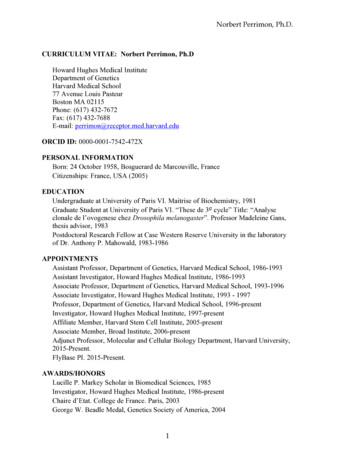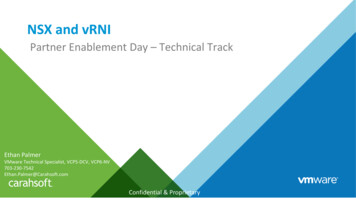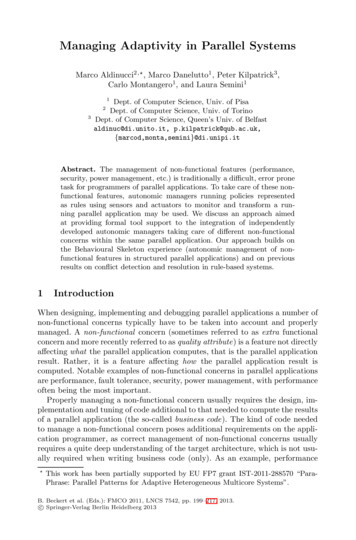
Transcription
Managing Adaptivity in Parallel SystemsMarco Aldinucci2, , Marco Danelutto1 , Peter Kilpatrick3 ,Carlo Montangero1, and Laura Semini11Dept. of Computer Science, Univ. of PisaDept. of Computer Science, Univ. of TorinoDept. of Computer Science, Queen’s Univ. of Belfastaldinuc@di.unito.it, ipi.it23Abstract. The management of non-functional features (performance,security, power management, etc.) is traditionally a difficult, error pronetask for programmers of parallel applications. To take care of these nonfunctional features, autonomic managers running policies representedas rules using sensors and actuators to monitor and transform a running parallel application may be used. We discuss an approach aimedat providing formal tool support to the integration of independentlydeveloped autonomic managers taking care of different non-functionalconcerns within the same parallel application. Our approach builds onthe Behavioural Skeleton experience (autonomic management of nonfunctional features in structured parallel applications) and on previousresults on conflict detection and resolution in rule-based systems.1IntroductionWhen designing, implementing and debugging parallel applications a number ofnon-functional concerns typically have to be taken into account and properlymanaged. A non-functional concern (sometimes referred to as extra functionalconcern and more recently referred to as quality attribute) is a feature not directlyaffecting what the parallel application computes, that is the parallel applicationresult. Rather, it is a feature affecting how the parallel application result iscomputed. Notable examples of non-functional concerns in parallel applicationsare performance, fault tolerance, security, power management, with performanceoften being the most important.Properly managing a non-functional concern usually requires the design, implementation and tuning of code additional to that needed to compute the resultsof a parallel application (the so-called business code). The kind of code neededto manage a non-functional concern poses additional requirements on the application programmer, as correct management of non-functional concerns usuallyrequires a quite deep understanding of the target architecture, which is not usually required when writing business code (only). As an example, performance This work has been partially supported by EU FP7 grant IST-2011-288570 “ParaPhrase: Parallel Patterns for Adaptive Heterogeneous Multicore Systems”.B. Beckert et al. (Eds.): FMCO 2011, LNCS 7542, pp. 199–217, 2013.c Springer-Verlag Berlin Heidelberg 2013
200M. Aldinucci et al.optimization requires a clear vision of target architecture features in order to beeffective. Moreover, the non-functional code is often deeply interwoven with thebusiness logic code, thus resulting in much more difficult debugging and tuningof both business logic and non-functional concern management code.Radically different approaches may be taken to manage non-functional concerns if we recognize that non-functional concern management is a completelyindependent activity w.r.t. business logic (functional code) development. In fact,non-functional concern management can be organized as a policy insurance procedure piggy backed onto business logic code. The policies used while managingnon-functional concerns are the non-functional programs and the mechanismsused to implement these programs–typically those mechanisms used to “sense”the computation status and to “actuate” policy decisions–represent the assembler instructions of non-functional management.If this perspective is taken, then management of non-functional concerns maybe implemented as an autonomic engine associated to the business logic code.We can implement MAPE (monitor, analyze, plan, execute) loop based managers where monitoring and execution of actions–those devised by policies inthe analyze phase and planned by other policies in the planning phase–happenthrough the sensor and actuator mechanisms provided by the non-functionalconcern management assembly instructions. Fig. 1 outlines this general idea.Fig. 1. MAPE loop in autonomic management: the control flow is represented by solidarrow lines and the dependencies are represented by dashed linesPrevious work has demonstrated the feasibility of such an approach to nonfunctional concern management [2,3,18,1]. These works also pointed out twointeresting and somehow conflicting facts:– Best management policies may be provided by experts in the specific nonfunctional concern, rather than by “general purpose” non-functional concernexperts and/or application programmers.– Different non-functional concern management policies may lead to conflicts,that is decisions in relation to management of non-functional concern A mayimpair decisions in relation to management of non-functional concern B.
Managing Adaptivity in Parallel Systems201Therefore autonomic management of different non-functional concerns posesan interesting problem: how can we “merge” policies managing different nonfunctional concerns without incurring serious penalties due to policy conflicts?The rest of the paper introduces non-functional concerns and their autonomicmanagement in more detail (Sec. 2 and Sec. 3). Then conflict detection techniques are introduced (Sec. 4). Sec. 5 discusses formal support for policy mergingand presents experimental results to assess the complete methodology. Finally,conclusions are drawn in Sec. 6.2Non-functional Concern Management in ParallelComputingAs stated in Sec. 1, a non-functional concern is a feature related to how theresults of an application are computed rather than to what these results actuallyare. Typical non-functional concerns in parallel applications include:Performance. By far, the most significant non-functional concern in parallelprogramming. Usually, two distinct kinds of optimization may be required,either latency or service time optimization, with differing implications forthe pattern used to exploit parallelism.Security. Security requirements may be related to data processed and/or to thecode used to process input data to get output results. These requirementsmay vary depending on the kind of resources used to compute the parallelapplication: shared, private, reserved (i.e. not private, but with exclusiveaccess guaranteed).Fault Tolerance. Considering the number of resources involved in large-scaleparallel applications, it is quite common to experience hardware faults duringthe execution of an application. Thus fault tolerance is particularly criticalto ensure correct completion of applications in the event of failure of (partof) the resources used, especially in the case of long-running applications.Power Management. If different resources are available (with differences bothin terms of power consumption and of performance delivered) power savingbecomes a fundamental option in parallel processing, especially at large/extreme scale.In most cases, the management of these non-functional concerns requires quitecomplex activities, including:– Adoption of more complex mechanisms and tools with respect to thoseneeded to support business code only. For example, to ensure security, SSLconnections may be required instead of plain TCP/IP connections.– Parallelization of sequential code or further parallelization of parallel code.For example, in a data parallel computation the input data should be partitioned among a larger number of threads to ensure a shortened completiontime of the application. Or the presence of a sequential bottleneck in a parallel computation may require parallelization of the bottleneck code.
202M. Aldinucci et al.– Complete restructuring of the parallel application, i.e. changing the paralleldesign pattern used to exploit parallelism in the application. For example,having first used a stream parallel pattern, we may realize that the performance of our parallel application is not sufficient and may therefore applysome data parallel pattern also on the different stream parallel pattern components.In general, various policies may be adopted to deal with non-functional concerns, with different applicability pre-conditions and different results. For example, when dealing with performance, if an application is not performing asexpected when running on a heterogeneous architecture, we can either try tomove parallel computation components of the application to more powerful architecture nodes (processing elements) or we can try to improve the “structure”of the parallel application (e.g. by changing the parallel pattern used) to givebetter performance on the existing and available computing resources.It is worth pointing out that, in general, it is easier to devise suitable management policies when the structure of the parallel application is completelyexposed. If the structure is not exposed, it is much more difficult to determinewhat exactly is going on and thus to plan corrective action in the event of a(non-functional) malfunction of the application. Indeed, without a general viewof the application parallel structure, it may even be difficult to realize that thereis a non-functional malfunction.If the parallel pattern of the application at hand is completely exposed we areenabled:1. to verify whether the application is performing as expected, as the (parallel)design pattern used will come with models that can be verified while theapplication is running; and2. to take the decisions suggested by the design pattern used to correct possibleproblems/malfunctions.Of course, the parallel pattern–or the pattern composition–used within the application may be identified in two distinct ways: i) by analyzing the HLL (HighLevel Language) code used to program the application (e.g. where we use a programming framework based on algorithmic skeletons), or ii) by running somekind of (data flow) analysis on the application code to determine whether theunderlying parallel activities fit one of the known parallel patterns.3Autonomic Management of Non-functional ConcernsAutonomic managers of non-functional concerns may be programmed as outlinedin Sec. 1 using MAPE loops. A MAPE loop is a control loop cycling on fourdifferent phases (see Fig. 1):M A monitoring phase, where the current status of the running parallel application is observed by collecting data on what happens on the actual targetarchitecture: how many (partial) results have been computed, the time spent
Managing Adaptivity in Parallel Systems203Fig. 2. Implementation of ECA rulesin the different running tasks, the amount of resources used (CPU, Memory,Network), etc.A An analyze phase, where the current situation is analyzed, the behaviour ofthe parallel application is compared to the expected behaviour and, possibly,a plan to improve application behaviour is selected.P A plan phase, where the decisions taken in the analyze phase are turned intoa sequence of actions to be run on the current application.E An execute application, where the plan is actually executed.The monitoring and plan execute phases rely on the existence of a set of mechanisms with the ability to “sense” application behaviour and to “act upon”application execution, i.e. to apply the plans devised by the manager policiesin the analyze plan phases. These mechanisms–sensors and actuators–represent“passive” code, as they are just called from within the manager. They also represent de facto the interface of the autonomic manager with the (running) businesscode of the application and determine the kind of policies that can be effectivelyimplemented in the manager.To clarify the concept, consider an application whose parallel pattern is basedon the master/worker paradigm. The availability of sensors reporting to themonitoring phase the number of workers executing and the service time deliveredby the master/worker combination determines the capability to react to poorlyperforming application states. In the same way, the availability of sensors capableof reporting whether a parallel application component is running on a private oron a public resource will enable the manager policies to take correct decisionsto ensure application security. On the other hand, the existence of mechanisms
204M. Aldinucci et al.(actuators) capable of stopping and restarting the application, recruiting newresources and deploying and starting active code on the these newly acquirednodes is fundamental to implementation of smart management policies, such asincreasing the number of workers in the master/worker pattern or moving anapplication component from a public node to a private/reserved node.As far as the “active” part of the MAPE loop is concerned–the analyze andplan phases–different choices can be made. Plain code can be used to hard-wirepolicies and plans and to call the sensor and actuator mechanisms. However, ifwe wish to experiment with different policies, or investigate changing policies“on-the-fly” depending on the perceived application status, a more dynamicand declarative solution is necessary. Various systems, including the authors’Behavioural skeletons [2,3], use ECA (Event Condition Action) rule systems toimplement manager policies.An ECA rule is applied in a context that consists of the status of the systemat the beginning of the MAPE cycle and the set of events that occurred inthe previous cycle. Events may be external, that is generated in the systemenvironment, or internal, that is generated as part of the effect of an actionperformed in the previous cycle. The application of a rule results in a new stateand possibly in (internal) events, to be considered in the next cycle, when alsothe external events received in the current cycle will be considered.More precisely, an ECA rule is a triple trigger, condition, action Whether a rule is applied in a MAPE cycle depends on its trigger and condition.The trigger is a pattern describing of the events that may cause the applicationof the rule (a.k.a. firing of the rule). At the beginning of the cycle, the triggeris matched with the events in the current context. In case of success, the rulebecomes ready to fire: it actually fires, that is, its action is executed, only if itscondition holds in the current state. An event that is not matched, or is matchedwhen the condition does not hold, is lost. A single event can enable two or morerules if it matches their triggers. In the case two or more rules are enabled in anevaluation step they are fired concurrently.The matching process may bind parameters in the trigger to the values carriedby the event: the scope of such binding covers the rule condition and action, thusenhancing the capability of the notation to express complex policies. For the samepurpose, two triggers may be disjoint, meaning that either is sufficient to applya rule, and conditions may be combined with the standard logical operators.Fig. 2 shows how selectors and actuators can enact ECA rules.The use of ECA rules allows a better implementation of the manager policies.In particular, we use the triggering event to start rule evaluation. In previouswork, we used JBoss rule syntax to express management rules. In that case ruleswere tested cyclically for fireability. The period of the cycle de facto determinedthe MAPE loop efficiency, as “too slow” loops react poorly and “too fast” loopsmay lead to overly rapid decisions. In the following sections, we adopt the rulesystem of Appel (see Sect. 5.1) to implement our rule-based manager programs.
Managing Adaptivity in Parallel Systems205Fig. 3. Behavioural skeletonsAppel chooses rules for firing using a loop such as that mentioned above. However, the trigger events are gathered continually and an ordered list of events isexposed to the rule system at each loop iteration.It’s worth pointing out here that “planning” activities in our MAPE loopare not actually proper planning activities. Rather, the “plan” step in the loopconsists in applying a plan that has been already coded in the action part ofthe ECA rules used as the program of the autonomic manager. These rules mayalso include an action part that somehow modifies the rule set. For example,a rule priority may be lowered or a rule may be substituted by a different onewhich more precisely reflects the actions needed in the current situation. Thisnotwithstanding, the “plan” phase is actually a kind of “actuate one of thealready established plans” phase. At a rather higher level of abstraction, theprocess leading to the design of the rules used as the program of the MAPEloop is a kind of MAPE loop itself. The current situation is monitored and thenit is analyzed. During the analysis phase a policy is eventually identified whichturns into a plan to be actuated/executed by generating suitable loops for ourrun time MAPE loop.
2063.1M. Aldinucci et al.Behavioural SkeletonsBuilding on the concepts detailed in the previous Sections, we proposed sometime ago the concept of Behavioural skeleton, i.e. of a parallel design patterncoupled with an autonomic manager taking care of a non-functional concern. Inthe original behavioural skeleton design, the parallel design patterns consideredwere the traditional ones in stream parallel computing models, that is task farmand pipeline. Task farm (a.k.a. abstraction of the master/worker implementationpattern) completely captures and models embarrassingly parallel computationon streams. Pipeline, instead, captures and models computation in stages, without backward communications. Also, the original behavioural skeleton designconsidered management of only a single non-functional concern: performance.The behavioural skeleton approach is outlined in Fig. 3. A behavioural skeleton library is made available to the application programmer. The library containsseveral composable behavioural skeletons. Each behavioural skeleton consists ofa parallel design pattern and of an autonomic manager running a MAPE loopand using an ECA rule system to implement policies. Suitable sensors and actuators are implemented within the parallel design pattern implementation tosupport autonomic manager activities.The application programmer in charge of writing a parallel application choosesa behavioural skeleton or some composition of behavioural skeletons from the BSlibrary and provides the behavioural skeleton(s) business logic parameters. Forexample, if the pattern used to express parallelism within the application is apipeline, the application programmer chooses the pipeline behavioural skeletonand instantiates it passing as parameters the code (wrappers) implementingthe business logic of the pipeline stages. If one of the stages has to be furtherparallelized, the application programmer may pass as pipeline stage an instanceof a task farm whose worker parameter implements the parallel stage businesslogic.Once the application programmer has written his/her application using behavioural skeletons, a compiler takes care of producing suitable parallel code forthe target architecture at hand. This code relies on the functions provided bythe behavioural skeleton run time library, of course.It is worth pointing out several notable features of this approach:– the system concerns (those requiring specific knowledge concerning the target architecture/system at hand) and the application concerns (those requiring more domain specific knowledge related to the application field) are keptcompletely separate. Separation of concerns clearly enforces productivity andefficiency in both application and system programmer activities.– the application time-to-deploy is significantly reduced by reuse of behaviouralskeleton library components.– performance portability across different architectures is the responsibility ofsystem programmers (as opposed to application programmers) who provide,in the behavioural skeleton library, components specific for the different target architectures.
Managing Adaptivity in Parallel Systems207– policy programmability is ensured by the ECA rule system embedded in theautonomic manager MAPE loop. Programming rules (declarative style) ismuch more user friendly and efficient than writing specific code using thesensors and actuators provided by the associated design pattern.Leveraging on all these attractive properties, a prototype implementation of behavioural skeletons on top of the ProActive/GCM middleware has been demonstrated to be able to carefully manage performance in stream parallel applications [3].4Conflict Detection and Resolution in Rule-BasedSystemsPolicy conflict has been recognized as a problem and there have been someattempts to address it, mostly in the domain of access or resource control [17].Kind of Conflicts. ECA rules conflict if (1) they may be triggered at thesame time and (2) their conditions overlap and (3) their actions conflict. Whilethis definition makes complete sense only in a specific application domain, asone must be aware of what conflicting actions are, the problem is inherent topolicies. To ensure that policies can be applied it is necessary to remove conflicts.This process involves two stages: first one needs to identify whether conflictscan occur, that is to detect conflicts, and then to remove them, that is resolveconflicts.The general definition of policy conflict can be extended to accommodatesome special cases.In [8] the authors discuss what it means for two rules to be triggered at thesame time, providing two different interpretations: their trigger sets overlap (andthe actual triggering event is in the overlap) or the action of one is in the triggerset of the other. The former case has been called STI (Shared Trigger Interaction)and the latter SAI (Sequential Action Interaction).More generally, and this provides interesting future work in our case, thedesigner may be interested in specifying conflicts on the basis of traces, i.e.define as conflicting rules that (1) may be applied within n MAPE loops and (2)whose actions conflict.One further aspect to consider, and this is again based on experience in feature interaction, is the question as to how many policies are required to generate a conflict. In the community, discussions have taken place around a topiccalled “three-way interaction”. In the feature interaction detection contest atFIW2000[9] this was an issue, and the community decided that there are twotypes of three-way interaction: those where there is already an interaction between one or more pairs of the three features and those where the interactiononly exists if the triple is present. The latter were termed “true” three-wayinteractions.
208M. Aldinucci et al.Nothing has been written about true three-way interaction, as only one, quitecontrived, example of such an interaction has been found. Hence we considerrealistic to assume that no “true” three-way interaction may occur, and limitourselves to pair wise checking.Conflict Detection Time. We distinguish between design time (static) andrun-time detection. In run-time detection, conflicts, if any, are looked for at eachexecution step among the rules that can be applied at the step. When conflictdetection is anticipated at design-time, rules are filtered before being entered inthe policy engine, to detect those that would originate conflicts. In this way wecan provide the user with confidence that the rules are conflict free.In our former works we addressed design time detection. In [13,14], we takea logic–based approach to this end: conflicts are detected by deducing specificformulae in a suitable temporal logic theory. In [6] we exploit the use of modelchecking to detect policy conflict. This is the approach employed in this paper.Layouni et al. in [11] also experimented with the use of the model checkerAlloy [5] to support policy conflict resolution.Conflict Resolution. Conflict resolution can in general be attempted in anumber of ways, and which is best suited depends on the situation. We canbroadly distinguish between resolution at design–time and resolution at run–time. The taxonomy of policy conflict in [17] makes explicit that design-timeresolution is always feasible when policies are co-located and owned by the sameuser. In this case resolution will be a redesign of the policies. However, whenpolicies are distributed, this is not always possible and it is preferable to dealwith conflicts at run-time. Resolution in this case may exploit priorities amongpolicies, activating only policies with greater precedence. Nevertheless, there is awide spectrum between the two extremes of co-location and complete distributedplacement, and any conflict that is resolved before run-time is of benefit.A comprehensive survey on detection and resolution techniques in three wellknown policy management approaches, KAoS, Rei and Ponder, is found in [20].5Multiple Non-functional Concern Management: FormalTool SupportThe ability to develop independent managers and to modify them to accomplishcoordinated management of multiple concerns is attractive for two reasons: itenforces modular design and reuse; and allows better use of domain specificknowledge of different non-functional concerns.However, combining a set of single-concern managers may be difficult toachieve since it requires expertise in all of the non-functional concerns to becoordinated, and because the sheer number of evolution paths of the combinedmanagers may make it extremely difficult for the human to identify the possibility of a conflict arising.
Managing Adaptivity in Parallel Systems209Model checking tools may provide fundamental support, however, as proposedin [6,10]: “conflicts” can be detected by model checking, once the conflictingatomic actions have been identified. More precisely, the whole design phase includes the following steps:– Independent experts design and implement policies relative to distinct nonfunctional concerns.– A set of conflicting actions is defined, such that a pair of actions ai , aj arein the set iff action ai “undoes” action aj and vice versa.– A formal model of the rule system is derived, which is fed to a model checker.– The model checker is used to check formulas stating that conflicting actionsmay occur “at the same time”, that is in the same MAPE loop iteration.– The traces leading to the situation with the conflicting actions obtained fromthe model checker are used to change the rules to handle conflicts.15.1An Experiment in Static Conflict Detection for AutonomicManagersIn the sequel, we first describe our experimental setting, and then discuss ourfirst results, with respect to the likelihood of applying the technique to reallife examples. The ingredients of the technique are a policy language, a modelchecker and a translator able to generate a checkable model from the policies.Appel. We use Appel [22,21] to write the management rules. Appel is a general language for expressing policies in a variety of application domains: it isconceived with a clear separation between the core language and its specialization for concrete domains, a separation which turns out very useful for ourpurposes.In Appel a policy consists of a number of policy rules, grouped using a numberof operators (sequential, parallel, guarded and unguarded choice).A policy rule has the following syntax:[when trigger] [if condition] do actionThe core language defines the structure but not the details of these parts, whichare specifically defined for each application domain: base triggers and actionsare domain-specific atoms; an atomic condition is either a domain-specific or amore generic (e.g. time) predicate. This allows the core language to be used fordifferent purposes. In our case, as mentioned above, the triggers relate to activesensors, conditions to (passive) sensors, and actions to actuators.Triggers can be combined with a disjunction, complex conditions can be builtwith Boolean operators, and a few operators (and, andthen, or and orelse)are available to create composite actions.1At the moment conflicts are identified by the model checker, but then the actionsneeded to resolve the situation (i.e. the modifications to the manager rules) are performed by humans. The asymptote is to have this part also executed automatically.
210M. Aldinucci et al.The semantics of Appel [,] which before was only defined informally, as withmost policy languages, has been formally defined by translation into the temporallogic ΔDSTL(x) [15,16].Though Appel supports also a notion of priority among the rules, we do notexploit this currently.UMC. This is an on-the-fly analysis framework [12,23,19] that allows the user1. to interactively explore the behaviour of a UML state machine;2. to visualize abstract slices of its behaviour; and3. to perform local model checking of UCTL formulae, UCTL being a branchingtime temporal logic [7].The last feature is the most important for our purposes, but the previous onesare very useful once a conflict is detected and we need a deep understanding ofwhat is happening to resolve it.UCTL allows specification of the properties that a state should satisfy andcombination of these basic predicates with advanced temporal operators dealingalso with the performed actions. Some care must be taken in writing the formulaethat characterize the conflicts to be detected, since they are checked not againstthe traces of the UML state machine, but against the traces of an equivalentstandard state machine – generated by UMC – where parallelism is resolvedwith interleaving. So to detect two conflicting parallel actions one has to detectany sequence of the actions in any path in the traces.Appel2UMC. We have defined a semantics-preserving compositional mappingfrom Appel to UML, suitable for model checking with UMC. Since UMC operates on UML state machines, the target of the mapping happens to be a subsetof UML state machines: policies and policy groups are defined using composite states, i.e. states with structure reflecting the one imposed by the Appeloperators onto policies and actions.To derive a UML state machine model of the system to feed the checker, we
at providing formal tool support to the integration of independently developed autonomic managers taking care of different non-functional concerns within the same parallel application. Our approach builds on the Behavioural Skeleton experience (autonomic management of non-functional features in structured parallel applications) and on previous

